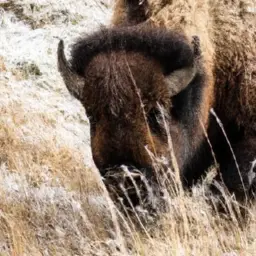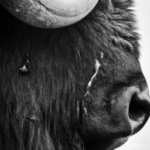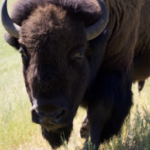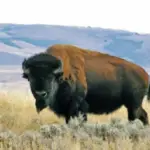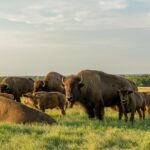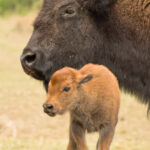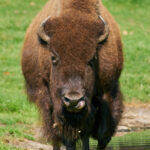Imagine standing on the vast plains of North America, witnessing the majestic sight of herds of bison roaming freely in the wild. But have you ever wondered how many of these iconic creatures are left? The “How Many Wild Bison Are Left” product provides an essential answer to this question, offering comprehensive details and statistics on the current population of wild bison. With its fascinating insights, this product allows you to delve into the status of these magnificent animals and deepen your appreciation for their conservation.
Understanding the Basics of Bison
Definition of Bison
Bison, scientifically known as Bison bison, are large herbivorous mammals that belong to the Bovidae family. These majestic creatures have a robust build, with shaggy coats, humped shoulders, and a distinctive set of curved horns. They are native to North America and are closely related to cattle and other bovines.
Bison are known for their endurance, agility, and adaptability. They have a fascinating social structure and are often found in groups called herds. These herds are led by dominant bulls, who play a crucial role in maintaining the cohesion and organization of the group. Bison are primarily grazer animals, meaning they feed on grass and other vegetation, and they play an essential role in shaping the ecosystems they inhabit.
Difference between Bison and Buffalo
While the terms “bison” and “buffalo” are often used interchangeably, there is a subtle difference between the two. Bison, as mentioned earlier, are native to North America and belong to the Bovidae family. On the other hand, buffalo refers to species native to Africa and Asia, such as the African buffalo and the water buffalo.
Despite this distinction, the terms bison and buffalo are often used interchangeably in colloquial language. This usage is mainly due to historical factors and cultural influences. In North America, the term “buffalo” has been commonly used to refer to the American bison, which led to the confusion between the two terms.
General Characteristics of Bison
Bison are remarkable creatures with a set of distinctive characteristics. They have a massive build, with mature bulls often reaching heights of around six feet at the shoulder and weighing up to 2,000 pounds. The shaggy coat of bison is composed of long, coarse hair that helps protect them from harsh weather conditions.
Bison possess a set of curved horns, which are typically present in both males and females. These horns can vary in size and shape but serve as important tools for defense and intraspecies communication.
These animals are well-adapted to their environment and can withstand extreme temperatures, ranging from scorching summers to freezing winters. They have a muscular physique, which allows them to cover vast distances in search of food and water. Bison are known for their endurance and can run at speeds of up to 35 miles per hour.
History of Bison Population
Initial Bison Population
Historically, bison populations were incredibly abundant in North America. It is estimated that before European colonization, there were millions of bison roaming the Great Plains. They inhabited a wide range of habitats, including grasslands, prairies, and even forested areas. Bison played a vital role in the lives of Native American tribes, who held deep cultural and spiritual connections with these majestic creatures.
Reasons for Bison Decline
Unfortunately, the history of bison population is marked by a significant decline. The arrival of European settlers in North America in the 17th century brought about a rapid decrease in bison numbers. Several factors contributed to this decline, including unregulated hunting, land encroachment, and the impact of diseases brought by domestic cattle.
Hunters sought bison for their valuable hides and as a means to control Native American populations by eliminating their main food source. The spread of railroads across North America further intensified the hunting of bison, as their hides became highly sought after commodities.
20th Century Bison Situation
By the turn of the 20th century, the once-thriving bison population had been decimated. It is estimated that by the late 1800s, less than 1,000 bison remained in North America. The near-extinction of this iconic species highlighted the urgent need for conservation efforts and led to the recognition of the bison’s ecological importance.
Current Population of Wild Bison
Number of Wild Bison Today
Today, the number of wild bison has seen a modest recovery compared to its historical lows. It is estimated that there are approximately 30,000 bison in North America, with the majority residing within protected areas such as national parks and wildlife refuges. These populations are scattered across different regions, including the United States and Canada.
While the current population of wild bison is encouraging compared to previous centuries, it still represents a fraction of the historical numbers. Continued conservation efforts are necessary to ensure the long-term survival of these magnificent creatures.
How Population is Counted
Counting the population of wild bison is a challenging task due to their wide-ranging nature and the vastness of their habitats. Traditional methods of counting involve aerial surveys, which provide a bird’s-eye view of the herds and their distribution. Researchers and conservationists also rely on ground surveys, camera traps, and genetic monitoring to estimate population sizes, track movement patterns, and assess genetic diversity.
Main Habitats of Wild Bison
Wild bison can be found in various habitats across North America. They are most commonly associated with grasslands and prairies, where they graze on a variety of grasses and forbs. Bison herds can also inhabit woodland areas and rugged terrain, showcasing their adaptability to different ecosystems. National parks and protected areas play a vital role in preserving these habitats and providing safe havens for bison populations.
Protected Species Status and Conservation Efforts
Legislation and Policies Protecting Bison
Recognizing the importance of bison conservation, several legislations and policies have been put in place to protect these majestic creatures. The American Bison Society, established in 1905, played a significant role in advocating for the protection and restoration of bison populations. In 2016, the American bison was designated as the official mammal of the United States, signifying its cultural and ecological significance.
Furthermore, national parks and wildlife refuges have been established to safeguard bison habitats and provide them with the necessary protection from hunting and other threats. These designated areas, along with the Endangered Species Act and other conservation measures, contribute to the preservation of the bison population.
Efforts to Increase Bison Population
Conservation organizations and government agencies have been actively involved in efforts to increase the wild bison population. These initiatives have focused on promoting habitat restoration, implementing captive breeding programs, and reintroducing bison to suitable areas where they have been extirpated.
Furthermore, there are ongoing efforts to create corridors that allow bison herds to freely move across landscapes. This promotes genetic diversity and the reestablishment of historical migration patterns.
Roles of Conservation Organizations
Conservation organizations play a vital role in protecting and conserving wild bison populations. They collaborate with government agencies, indigenous communities, and other stakeholders to implement conservation strategies, conduct research, and raise awareness about the importance of bison conservation. These organizations work tirelessly to ensure that future generations can witness the beauty and ecological significance of wild bison.
Challenges Affecting the Population of Wild Bison
Climate Change Impact
Climate change poses significant challenges for bison populations. Rising temperatures, altered precipitation patterns, and increased frequency of extreme weather events can disrupt bison habitats and food availability. Melting snowpacks and reduced water sources can also impact their ability to access freshwater, which is essential for their survival.
Threats from Diseases
Diseases transmitted from domestic livestock pose a significant threat to wild bison populations. Brucellosis, in particular, is a bacterial infection that can cause reproductive issues in bison and other animals. Efforts are being made to manage and mitigate the transmission of diseases between domestic livestock and wild bison, including the creation of buffer zones and vaccination programs.
Problem of Habitat Destruction
Habitat destruction remains a pressing issue for bison populations. Continued land development, agricultural expansion, and urbanization encroach upon their natural habitats, fragmenting landscapes and limiting their ability to roam freely. Conservation efforts must prioritize habitat protection and restoration to ensure the long-term viability of bison populations.
Bison in National Parks
Number of Bison in National Parks
National parks serve as important refuges for bison populations, providing them with protected areas where they can thrive. As of now, there are approximately 11,000 bison distributed across various national parks in North America. These parks play a crucial role in preserving the genetic diversity of these iconic creatures and showcasing their natural behavior.
Prominent National Parks with Bison
Several national parks in North America are renowned for their bison herds. Yellowstone National Park, located primarily in the United States but extending into Canada, is home to the largest population of wild, free-roaming bison. Other notable parks with significant bison populations include Badlands National Park, Wind Cave National Park, and Theodore Roosevelt National Park.
Management of Bison in National Parks
Managing bison populations in national parks involves a delicate balance between preserving the ecological integrity of these landscapes while addressing potential issues related to habitat carrying capacity and human-bison interactions. Park managers employ strategies such as controlled burns, habitat restoration, and regulated hunting to maintain healthy population sizes and ensure the overall health of the ecosystem.
Bison and Indigenous Cultures
Role of Bison in Indigenous Cultures
Bison have played a central role in the cultures and histories of Indigenous communities for thousands of years. Tribes such as the Plains Indians developed sustainable relationships with bison, relying on them for food, clothing, shelter, and spiritual practices. Bison were regarded as sacred animals, symbolizing strength, resilience, and the interconnectedness of all living beings.
Impact of Bison Decline on Indigenous Communities
The severe decline in bison populations had devastating impacts on Indigenous communities. The loss of their primary food source not only affected their physical well-being but also shattered cultural traditions and disrupted their way of life. Forced relocation and assimilation policies further exacerbated the challenges faced by Indigenous communities, depriving them of their ancestral lands and cultural identity.
Indigenous Efforts in Bison Conservation
Despite the historical challenges, Indigenous communities have been at the forefront of bison conservation efforts. They have spearheaded initiatives to restore bison populations on tribal lands, emphasizing the importance of traditional ecological knowledge and sustainable management practices. These efforts not only contribute to the preservation of bison but also foster cultural revitalization and strengthen community ties.
Bison and the Economy
Economic Value of Bison
Bison have significant economic value, both in terms of direct and indirect contributions. Bison ranching and farming have become an important industry, providing a sustainable source of meat, leather, and other products. Bison meat, in particular, is highly regarded for its nutritional value, lean nature, and distinctive flavor, making it a sought-after choice for health-conscious consumers.
Bison’s Role in Tourism
Bison serve as a major attraction for tourists visiting national parks and other protected areas. Their prominent presence and cultural significance draw visitors from around the world who wish to witness these majestic creatures in their natural habitats. Bison-related tourism plays a significant role in generating revenue for local economies and supporting businesses that cater to visitors.
Impact of Bison Farming
The practice of bison farming has gained traction in recent decades, with ranchers raising bison for commercial purposes. While this industry contributes to the economy and provides a sustainable alternative to conventional livestock farming, it also raises questions regarding animal welfare and the potential impacts on wild bison populations. Responsible and ethical farming practices are crucial to ensure the well-being of both captive and wild bison.
Role of Bison in Ecosystems
Bison’s Ecological Role
Bison have a profound impact on the ecosystems they inhabit. As grazers, they help shape vegetation dynamics and maintain the balance between grasses and forbs, which promotes biodiversity. Their grazing habits also create open spaces and disturbances that facilitate the growth of different plant species and provide habitats for various animals.
Bison also play a pivotal role in nutrient cycling. Their dung acts as a natural fertilizer, enriching the soil and enhancing its fertility. Additionally, their wallows and hoof prints create microhabitats for numerous species, such as insects and amphibians, further contributing to the overall ecosystem diversity.
Impact of Bison on Soil Fertility
In ecosystems where bison graze, the vegetation benefits from their presence in several ways. The constant grazing and trampling of bison stimulate grass growth, leading to the accumulation of organic matter in the soil. This organic matter, coupled with the nutrient-rich dung, enhances soil fertility, increases water infiltration, and improves the overall health of the ecosystem.
Effect of Bison Herd Reduction on Ecosystems
The reduction of bison herds can have significant consequences for the ecosystems they occupy. As herd sizes decline, grazed areas become less managed, leading to imbalances in vegetation and potential overgrowth of certain plant species. Reduced trampling and dung deposition may also affect soil fertility and nutrient cycling, potentially impacting other plant and animal species that depend on a healthy and diverse ecosystem.
Can Bison Population Decline be Linked to Land Availability?
The decline in bison population can be directly linked to land availability. The issue arises from the fact that bison need vast expanses of land to roam and graze. As human development encroaches on their habitats, the availability of how much land bison need is increasingly restricted, leading to population decline.
The Future of Wild Bison
Predicted Population Trends
While the current population of wild bison is relatively stable, the future trajectory of their numbers will depend on several key factors. Continued conservation efforts, habitat restoration, and managed reintroductions are expected to help increase population sizes in certain areas. However, challenges such as climate change, disease transmission, and habitat loss must be effectively addressed to ensure the long-term survival of wild bison populations.
Efforts to Ensure Bison Survival
To ensure the survival of wild bison, ongoing efforts are being made to protect and restore their habitats, manage disease transmission risks, and create connected landscapes that facilitate genetic exchange. Collaborative partnerships between government agencies, conservation organizations, ranchers, and Indigenous communities are crucial for implementing comprehensive strategies that address the multiple threats faced by wild bison populations.
Aspects Shaping the Future of Wild Bison
Several aspects will shape the future of wild bison. The development and implementation of sustainable land-use practices, along with policies that prioritize habitat protection, are essential for maintaining viable and interconnected populations. Continued research and genetic monitoring will provide insights into the health and genetic diversity of bison populations, guiding conservation efforts.
Public education and awareness about the ecological importance of bison and the cultural significance they hold will play a crucial role in fostering support for their conservation. By recognizing the value of these majestic creatures and taking collective action, we can ensure that future generations can appreciate the immense beauty and ecological contributions of wild bison.

